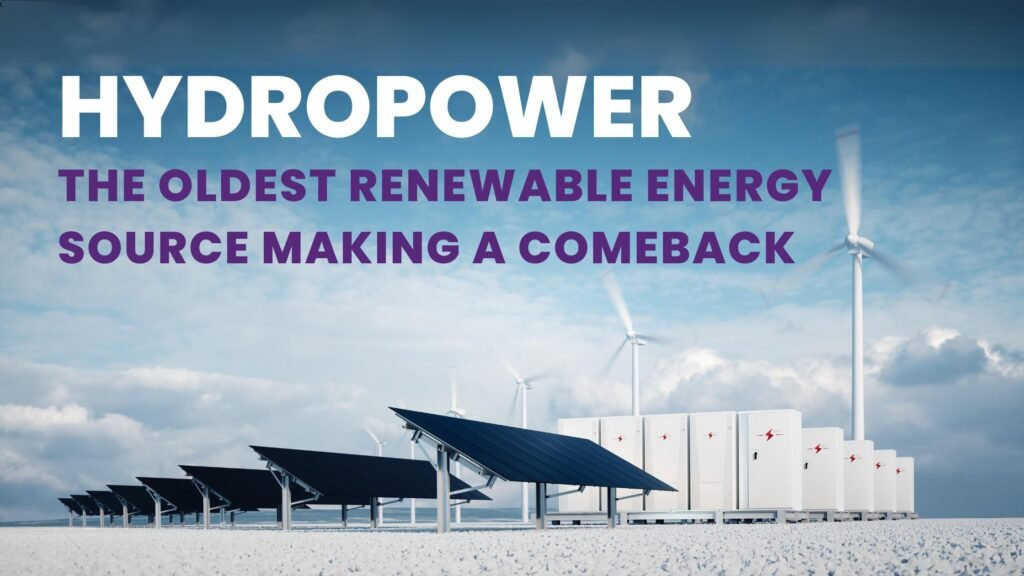Did you know hydropower, one of the oldest renewable energy sources, is making a remarkable comeback in the energy sector? Earlier, it used to be a dominant force, but now, with time, hydropower is re-emerging as a significant player in the global shift towards sustainable power solutions.
However, hydropower is being revitalized to meet modern energy demands with its advancements in technology and a renewed focus on reducing carbon emissions.
In this blog, we will explore how hydropower is regaining its importance, the factors driving its resurgence, and what impact it has on the environment.Stay tuned with us as we will dive into the benefits and challenges shaping hydropower’s comeback.
What is hydropower?
Hydropower, or hydroelectric power, is one of the oldest and largest sources of renewable energy, which uses the natural flow of moving water to generate electricity. Because water is an infinite resource, its cycle provides an endless recharging system, making it a renewable energy source.
There are several types of hydropower facilities, and they are all powered by the movement of flowing water. Turbines and generators are used to convert the water’s kinetic energy into electricity, which is then fed into the electric grid to supply homes, businesses, and industries.
Why Is Hydropower Considered a Renewable Energy Source?
Hydropower is considered a renewable source because it relies totally on the Earth’s water cycle, which naturally gets replenished by precipitation and gravity.
- A dam is constructed to create a water reservoir. Each time it rains, the reservoir will be refilled with water.
- The amount of water on earth has always been constant. The heat energy of the sun drives the flow of water on the earth in the form of the water cycle.
Therefore, hydropower is considered a renewable source of energy as it does not produce carbon emissions during operation, and it contributes to cleaner air and helps to mitigate climate change. This makes it a significant player in the global shift towards sustainable and renewable energy solutions.
How is hydropower making a comeback in renewable energy?
Hydropower is making a significant comeback in renewable energy, as a key player in the global shift towards sustainable energy.Heres how this energy is re-emerging in the renewable energy landscape.
- Modernization of Existing Plants
With the advent of modernization of plants, many countries are investing in modernizing old hydroelectric plants to improve the impact and increase capacity, and by upgrading turbines, generators, and control systems, they can enhance power output without building new dams, which will help to reduce environmental impact.
- Climate Change Adaptation
Hydropower plays a significant role in adapting to climate change by providing a stable and reliable source of electricity, especially when it comes to regions that are experiencing changing weather patterns that will affect solar and wind energy generation.
- Support for Grid Stability
Unlike other renewable energy sources like wind and solar, hydropower can provide consistent and flexible power to the grid, as it also helps in balancing supply and demand to ensure a stable electricity supply.
- Pumped Storage Hydropower
With time, pumped storage hydropower technology is gaining traction as a method to store excess energy that it generates from other renewable energy sources like wind and solar. However, this technology works by pumping uphill to a reservoir during low-demand periods and releasing it to generate electricity when demand is very high.
Hydropower Benefits and Challenges in 2024
While hydropower has numerous advantages, it also faces some challenges. Let’s explore both.
- Renewable and Clean: Hydropower is a renewable energy source that uses the natural water cycle because it gets replenished by rain and snow. It doesn’t produce greenhouse gas emissions during operation, which makes it a more environmentally friendly option.
- Reliable and Flexible: Flexibility helps to maintain grid stability and support the integration of other renewable sources, as hydropower plants can quickly adjust their output to match the demand for electricity.
- Low Operating Costs: The operating and maintenance costs are very low compared to other fossil fuel plants because once a hydropower plant is built, it is very affordable to operate.
- Flood Control and Water Management: Dams that are built for hydropower can help to control floods and water management, and they also give facilities like drinking water and other additional benefits to sustain.
Safety and climate challenges of hydropower plants
Hydropower is one of the oldest renewable energy sources. Despite being a key player in renewable energy, it faces several significant challenges, and because of that, our primary concern is its impact on the environment. One of the key safety concerns is about the risk of dam failure, which, although it happens very rarely, if it occurs it can have a devastating impact on the environment.However, climate change is another key challenge for hydropower because of its increasing temperatures and shifting perception patterns. Due to that, water availability can also become less predictable.
Moreover, hydroelectric plants are especially vulnerable to climate change, as dams are constructed with certain precipitation in mind that will be able to hold water during times of floods or, reversely, produce energy despite droughts. However, as extreme weather events such as hurricanes, droughts, etc. are becoming more common, new dams must take accountability for realities, while old dams must be evaluated to see whether they are up for the task.
Additionally, in Canada, changes in snowmelt patterns can result in reduced rainfall and can affect hydropower production, especially in regions like British Columbia, where hydropower contributes over 90% of the province’s electricity supply. These climate-related challenges make it crucial for the hydropower industry to develop strategies to maintain all the safety measures and should also ensure a stable energy supply in the face of changing environmental conditions.
The Resurgence of Hydropower in the Renewable Energy Sector
The resurgence of hydropower in the renewable energy sector is all because of the driven need for reliable and clean energy sources. Countries like the United States and Canada are investing in both small and large-scale hydropower projects to diversify their energy mix and reduce carbon footprints.
- Small Hydropower Plants: Hydropower plants can provide electricity to communities that do not connect to the main grid, whereas unlike large dams, hydropower plants have a minimal environmental impact and can be easily set up in remote areas.
- Hybrid Systems: Nowadays, hydropower is increasingly being used for renewable sources to create hybrid energy systems like solar and wind. This kind of combination allows for more reliable energy production, as hydropower can compensate for the other renewable sources.
Impact of Hydropower on Sustainable Development
Hydropower plays a key role in sustainable development by providing a clean and renewable source of energy, which helps to reduce greenhouse gas emissions and more reliance on fossil fuels. It contributes to better air quality and healthier ecosystems as it supports the generation of electricity with very minimal environmental pollution.
However, there are also challenges, as it can have an impact on river ecosystems, fish populations, and displacement of communities due to the construction of dams. It is very important to ensure balancing of both these benefits and challenges as hydropower contributes positively to sustainable development.
Additionally, hydropower projects have a good impact on the economic factor as they can create jobs, boost local economies, and improve infrastructure in surrounding areas.
The Future of Hydropower
The future of hydropower is connected to the modernization of existing infrastructure, as it might boost old dams and power plants with the latest technologies to improve their efficiency and can also reduce environmental impact.
Globally, $127 billion will be spent on updating plants between now and 2030. This amounts to about one-fourth of all the hydropower investments made worldwide and almost 90% of those made in Europe and North America.
However, the majority of investments are going toward new plants in other parts of the world. Over 75% of additional hydropower capacity is anticipated to come from large, state-owned projects in Asia and Africa by 2030.
Global hydropower growth is declining and is anticipated to decline by roughly 23% by 2030.The capacity to reverse this trend will mostly depend on expediting the permitting and regulatory procedures by establishing sustainability criteria and emissions monitoring programs that are accepted by the community. Moreover, a quicker development schedule would make it easier for developers to secure power purchase agreements because profits would be certain.
Final thoughts
We hope this blog helps you understand how hydropower is making a significant comeback in the renewable energy landscape. As we will explore, the resurgence of this reliable energy source is driven by advancements in technology, along with growing environmental concerns and the urgent need for sustainable energy solutions.
Access the fill guide and learn more by following our blog!





Leave a Reply